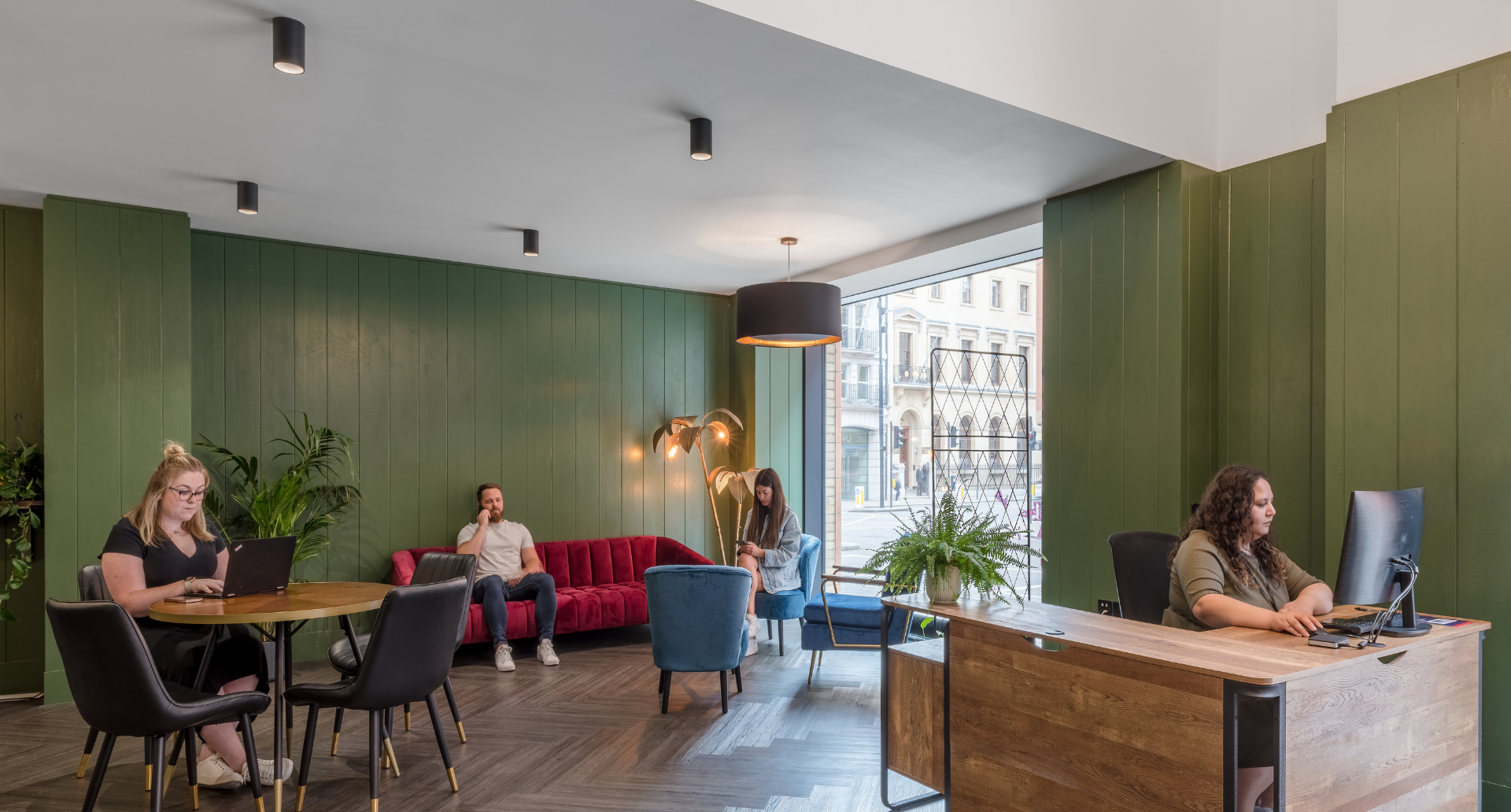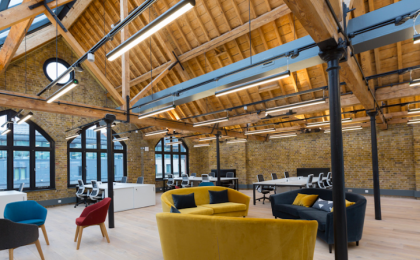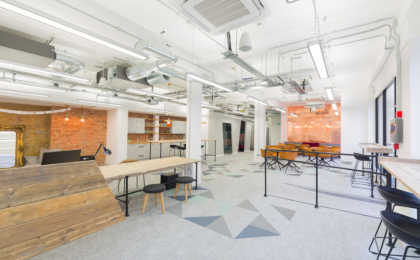
The move towards more flexible ways of working has been underway for some time, but the events of 2020 sped things up. Now, hybrid, remote, and flexible working habits are firmly in the mainstream – and they’re all facilitated by flexible workspaces.
But what exactly is a flexible workspace or office? And how does having one help businesses secure the benefits of flexible working? We’re here to answer all of those questions, and more, in our complete guide to flexible workspace offices.
What is a flexible workspace?
A flexible workspace, also known as a flexible office space or a flexspace, is simply a workspace that’s designed to offer flexibility. Flexible workspace is a catch-all term for any workspace other than a traditional long-term lease office, describing various different types of workspace including:
- Serviced offices
- Shared offices
- Coworking spaces
What makes these workspaces flexible? The main differentiator between a flexible workspace and the traditional office space is that the former is available on shorter-term leases. Whereas a traditional office space might require a 5+ year commitment, flexible workspaces are typically available on contracts as short as a month.
But there’s more to a flexible workspace than that. There are a range of other commonalities between flexspaces, including a transparent all-inclusive pricing model, a mix of different workspace types contained within one building, and more flexibility for members to scale their workspace size up or down according to their changing needs.
What comes with a flexible workspace office?
Flexible workspaces and the flexible offices that they typically contain are designed to be a simpler option than the long-lease traditional offices they’re aiming to replace. And that’s primarily reflected in their all-inclusive nature.
Offices in flexible workspaces are typically available for a single, simple, transparent price, which includes:
- The office space itself, generally fully-furnished
- Full cleaning and maintenance services
- Business rates, utilities, service charge, and building insurance
- Wired and wireless high-speed internet access
But that’s not all. While not a hard rule, it’s more common than not that a flexible office space will also come with a variety of additional features, facilities, and amenities, including:
- Access to bookable meeting rooms
- Various break-out spaces
- Shared or private kitchens
- A manned reception desk or on-site support team
- Other on-site amenities, like showers or a gym
Some of these additional features are included in the cost of a flexible office, while use of some others might incur an extra charge.
The benefits of a flexible office space
So, now that you know what a flexible office space actually is, we can move on to talking about why so many businesses choose to opt for one. The potential benefits of choosing an office in a flexible workspace include:
Easier budgeting
Since flexible offices are available for a single monthly cost, they’re much easier to manage from a financial perspective than traditional office spaces, with all their associated unincluded expenses.
That means it’s easier to keep on top of your budget, as you know exactly how much you’ll be paying for your office space every month. And flexible offices can also reduce the total amount you spend on your workspace, since you can choose a smaller space to accommodate a certain number of rotating hybrid workers, rather than looking for an office big enough to hold your entire team.
Less day-to-day hassle
Offices in flexible workspaces are generally fully serviced and also come fully-furnished. That significantly cuts down the amount of effort you have to put in to setting up and maintaining your space.
You can typically move in to a flexible office space right away, and can get straight down to work rather than spending weeks buying and assembling office furniture. Then, you don’t have to worry at all about the day-to-day cleaning and maintenance of the space, meaning you can continue to focus on what matters most.
Improved agility
Shorter, more flexible leases are one of the prime advantages of a flexible office space as opposed to a traditional alternative, and it offers businesses vastly improved workspace agility.
Instead of being locked into a prohibitive long-term lease, taking a flexible office space means that you can react to changes in your business’s situation or the economy at large. You can scale your space up or down as your team grows or shrinks, and leave your office altogether if it’s not longer suitable for your needs.
Networking opportunities
Working in a flexspace puts you in direct contact with the other businesses, freelancers, and remote workers that use it. That means you get access to networking opportunities that don’t exist in a pure work from home strategy or in a private office space.
These opportunities could turn into business partnerships or new clients, but they’re also just nice to have. That’s not to mention that your employees will also have more social contact, which can help keep them motivated and engaged.
How to choose the right flexible office space
With the basics out of the way, it’s time to answer the final question: how do you go about choosing the right flexible office space? There are several key factors to consider, which we’ll go through one by one.
First, you need to think about how your workplace strategy will impact what type of workspace will be right for your business. If you’ve fully embraced hybrid work and only have three people in the office a day, for example, you might want to consider hot desking instead of a private office.
Next, you need to move on to choosing the right office location. Location is, understandably, still one of the most important factors in a flexible workspace. Choosing an area that’s convenient to reach, has all the nearby amenities you need, and offers good value will narrow your search down.
Then, you can move on to thinking about office space size. Choosing the right size involves considering lots of factors, including how many people will be using it each day, how scalable you want it to be, and what kind of office environment you want to create.
Finally, you can refine your search by adding in any other parameters that matter to you, like the aesthetics of the flexible workspace you’re looking at, the price of an office, and what neighbours you’d have there.
To get started with your search, take a look through our collection of 30+ flexible workspaces throughout London and the rest of the UK today. They’re all completely serviced, come fully-furnished, and are based in some of the most beautiful buildings we could find. Perfect for your first steps into flexible working.
Related Posts

Oct 17 2018
Why you’ll love Notcutt House
In a nutshell? It’s a stylish alternative to the corporate high buildings of yesteryear. Notcutt House is home to many businesses varying in size and industry offering a home...
Read more
Apr 03 2017
Scandinavian Office Design 101
Scandinavian design, or Scandi design for short, has been growing in popularity for years in both residential and commercial settings. It’s clean,...
Read more
Mar 06 2023
Why We Love Dog Friendly Offices
Canine companions. Four-legged friends. Man’s best friend. Life would be a lot duller without dogs by our side, and so would offices! From reducing...
Read more



